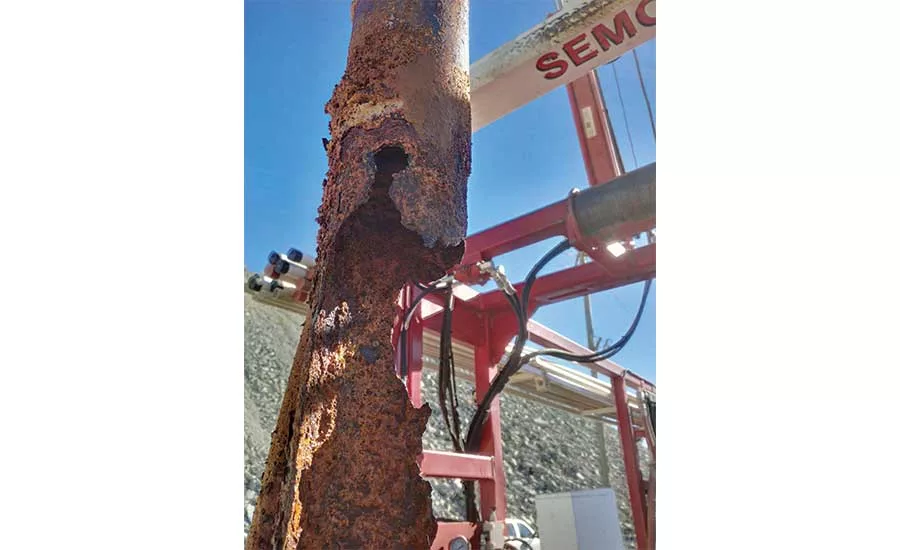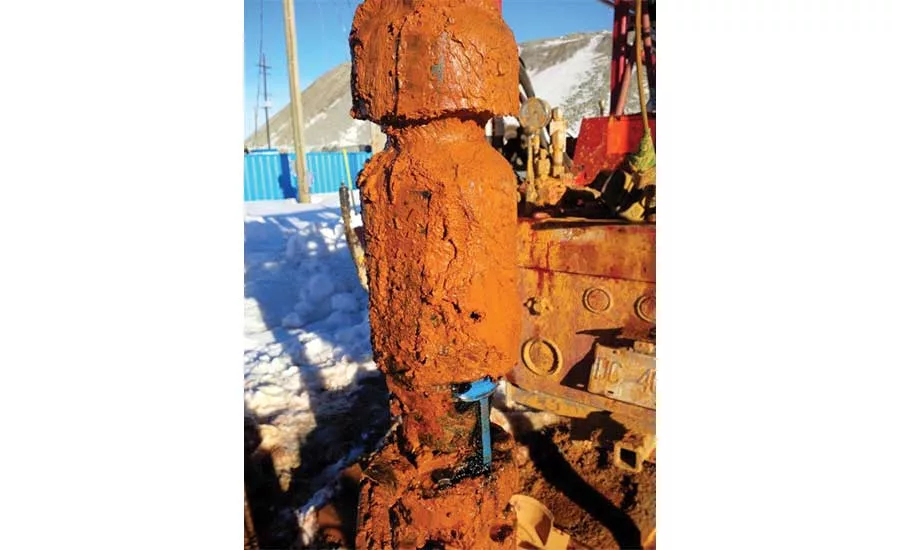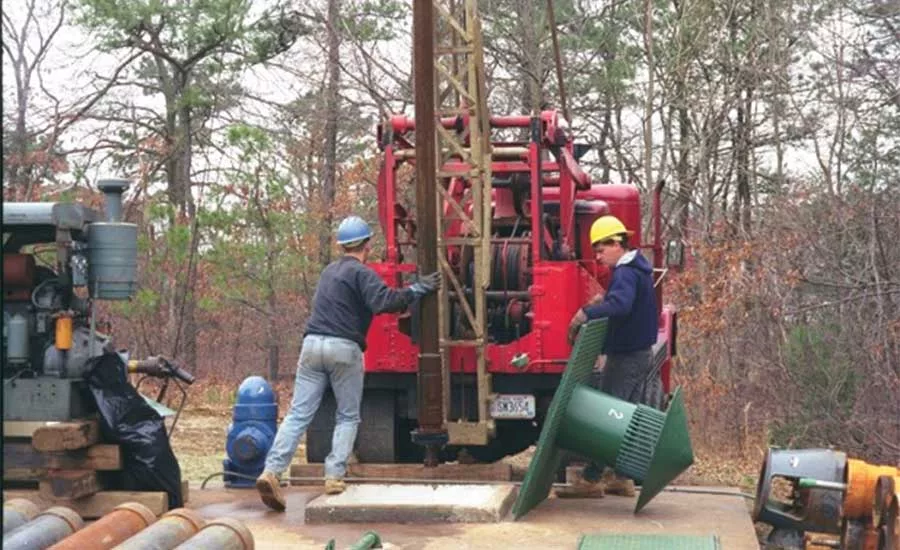Maintenance — A Win/Win for Contractor and Well Driller

Well issues like biofouling can, over the long term, cause significant corrosion.
Source: Ingram Well and Pump

Groundwater chemistry has the biggest influence in determining the rates that mineral scale will build up, and that chemistry is determined by the geology of the aquifer.
Source: Ingram Well and Pump

When it comes to surging or jetting a well, a cable tool rig works wonders.
Source: CETCO Drilling Products
This is based on an article that I wrote for Groundwater Canada magazine in 2015. I believe this is a very important subject, therefore, I thought it would be a good fit for National Driller as well.
Water is a necessity for every household in the United States. In America, there are more than 15 million households that rely on private water wells for drinking water. This accounts for roughly 15 percent of the population. In some states, there is a larger reliance on private water wells. In Wisconsin, for instance, 25 percent of the population uses a private water well for its source of drinking water. The homeowner’s expectation is that a water well should provide a reliable, consistent source of good quality drinking water. The homeowner also expects the water well to last a long time. In fact, the expectation may be that the well last as long as the house.
A water well is a constantly used, dynamic system. Any complex system requires regular maintenance in order to keep it running consistently and preserve the longevity of the system. Compare a water well to a home. A home is expected to provide a long-term, reliable and safe source of shelter. In order to do this, the house needs to be maintained. Without regular maintenance, including cleaning and repairs, the house will not necessarily be safe or reliable — or last very long. A private water well also requires maintenance in order to provide the safe, consistent, long-term supply of water. As per the EPA’s website, “The EPA does not regulate private drinking water wells. Many states and towns do not require sampling of private wells after installation. It is the responsibility of the homeowner to maintain the safety of their water.” Not only is the homeowner responsible for the safety of their water, they are also responsible for the physical maintenance of the well.
The homeowner typically does not have the expertise to understand the dynamics of a well and the maintenance required. Similarly, many car owners do not have the expertise to fix a car or even understand how the engine of a vehicle works. Car owners follow a maintenance schedule to ensure their vehicles are safe and well maintained in order to avoid a breakdown. This maintenance also helps extend the usable life span of their cars. As professionals in the water well industry, it is important to educate homeowners about the regular maintenance required to ensure their well’s long-term viability. Unfortunately, a lot of private well owners do not think about the importance of their water supply until something happens and they lose access to their water.
How often a well needs to be serviced is a function of the geology of the well. The geology of the aquifer type will also dictate the quality of the water. A well drilled in an alluvial deposit will need more frequent maintenance than a well drilled in a limestone aquifer. Other aquifer types include sandstone, interbedded sandstone and shale, and consolidated sedimentary to name a few. Basic preventative maintenance costs are roughly 10 to 20 percent of the cost for a full well rehabilitation. A full well rehabilitation is roughly 10 to 20 percent of the cost of having a new well drilled. Like a car, the cost to fix a well that you have not maintained will increase rapidly the longer you put it off. As a homeowner, it would be beneficial to have a scheduled maintenance program based on the geology, use and dynamics of the well. The maintenance program could even be bundled as a package along with the construction of the well. This would allow the contractor to not only help the homeowner keep their well safe and well maintained, but would also provide the contractor a steady flow of income. This would be a win-win for the homeowner and the well contractor.
The majority of well production problems fall into three categories. We’ll discuss each of those three conditions here, as well as suggestions for maintenance that contractors can discuss with well owners.
Mineral Scale
Mineral scale is a very common cause of reduced well production or complete failure. This mineral incrustation is caused by the precipitation of dissolved minerals on the well screen and pump from the groundwater. The chemistry of the groundwater has the biggest influence in determining the rates that this scale will build up. The chemistry of the groundwater, in turn, is determined by the geology of the aquifer. The regular use of water wells and the high velocity at which the groundwater is pulled through the screens and into the pump accelerate the deposits of the incrustation. The color of the mineral scale can give an indication of the type of scale:
- Iron = red/brown
- Manganese = black
- Sulfates= green/blue
- Calcium= white
Periodically having the groundwater tested for concentrations of these substances will allow a contractor to come up with the frequency of maintenance required for a homeowner’s well.
Biofouling
Biofouling is caused by the accumulation of bacteria on the well screen and pump. This phenomenon is caused by naturally occurring bacteria interacting with the components of the well. This slimy deposit is often referred to as iron bacteria. The problems associated with bacteria buildup are clogged screens and a reduction of pump efficiency. The buildup of living and dead bacteria can accumulate quite rapidly and can cause the start of mineral incrustation. Symptoms of a well affected by biofouling include a quick decline in the output due to clogged screens and biofilm on pumps. Biofouling can also lead to reduced water quality, resulting in the water having a bad odor or even a greasy sheen. In the long term, excessive biofilm can also cause corrosion of the well.
Physical Plugging
As water is pumped from a well, the resulting turbulence in the aquifer may slowly lead to the deposition of fine particles in the water-bearing formation. This often results in a slow reduction in the capacity of the well over the long term. It’s typically not much of a problem if the well is cleaned out (developed) properly when built. A well that has been developed well in the construction stage removes remnants of bentonite drilling fluid, as well as fines deposited during the drilling of the well. Well corrosion resulting in pits and holes forming on the well screen or casing will also lead to the accumulation of sediment in the well. Physical plugging is also a result of the use of the well beyond its design capacity.
Start with Benchmark Performance
In order for a water well to be maintained and to identify whether one or more of these problems may need to be addressed, a homeowner requires some benchmark information. This information is needed as a reference to determine the scope of the reduction in the performance of the well:
- Static water level (the elevation of the standing water in the well)
- Specific capacity of the well as determined by a pump test (along with pump rate, pump level, pumping time)
- Water quality analysis
- Depth of the well
A basic rule of thumb is that well rehabilitation is required if the specific capacity of the well is reduced by 25 percent or more.
A well is typically rehabilitated using a combination of mechanical cleaning and the use of well rehabilitation chemicals. There are also some companies that use other techniques, such as heat or shockwaves. A brief description of a typical well rehabilitation process starts with utilizing a mechanical brush to loosen up and facilitate the removal of mineral scale and biofouling. This works the same way as a chimney brush. This is then followed up with the introduction of a surfactant, which is surged through the well over a period of time to soften and loosen the incrustation by increasing surface tension. The surfactant will open up access to fissures and cracks within the buildup. Once the surfactant has had sufficient time to work, it is purged from the well.
The well or pump contractor will then dose the well with a chemical designed to dissolve, suspend and carry out the bacteria deposit that has built up in the well. This process may be quick or it can take 24 hours or more, depending on the severity of the deposit. The well contractor will continue to move the chemical throughout the well at this time through the use of surging, jetting, displacement or recirculation. This allows for the penetration of the chemical and removal of the biofilm in the well and surrounding area. As this chemical is an acid, the pH is monitored to determine if the acid is degrading and more needs to be added. Once the well water returns to neutral or is pumped out, another chemical is added to tackle the mineral incrustation. As mineral scale is often very hard, it may take longer to break down and dissolve. Again, this acid is required to be surged through the well into the formation. A cable tool rig is particularly useful to surge or jet a well through the well rehabilitation process. Once it is determined that the mineral scale has been removed, then the well is pumped clean of the chemical and can then be chlorinated. At this point, the specific capacity of the well is tested and recorded.
It’s important to note that well rehabilitation should always be performed by a licensed contractor. As a contractor, it is imperative to educate your clients on their well. Let them know the geology of the well, the benchmark data of the well and how it will impact their well over time. Providing a well maintenance program will ensure a good working relationship with the homeowner. This gives the homeowner the peace of mind knowing that their water well will run efficiently and produce the best quality water based on the geology of the aquifer. The contractor, in turn, will have a steady source of reliable income and create a lasting relationship with the client.
Looking for a reprint of this article?
From high-res PDFs to custom plaques, order your copy today!



